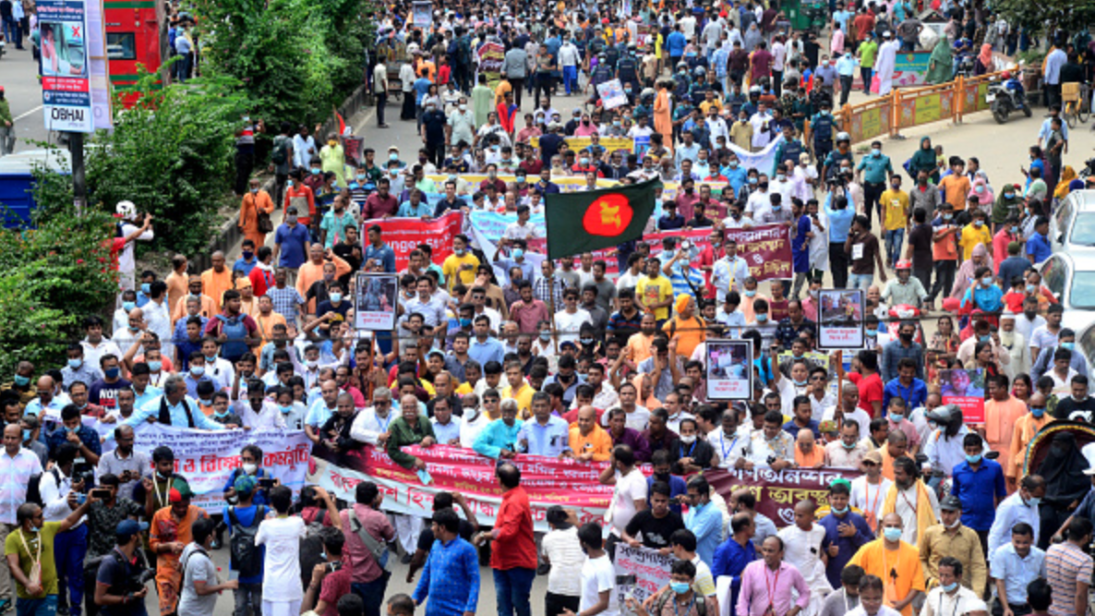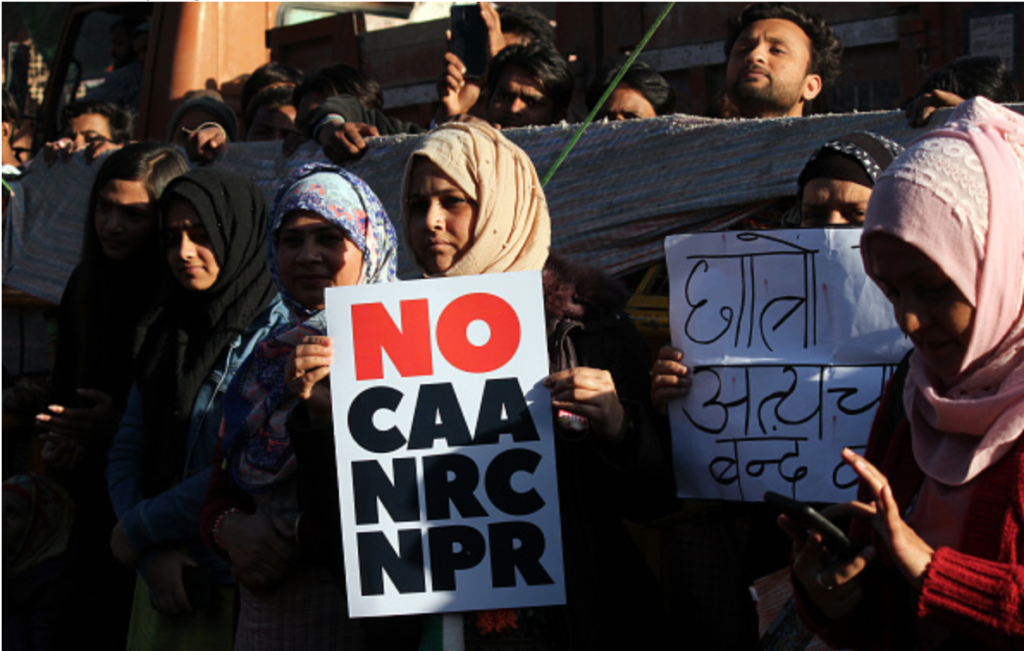
Bangladesh has witnessed a spate of communal attacks targeting its principal minority religious community, Hindus, with reports suggesting that miscreants attacked Hindu religious establishments across the state during the Durga Puja festival this October. The violence began after a social media post claimed that a copy of the central religious text of Islam, the Quran, had been desecrated at a Durga Puja pandal in Bangladesh’s Comilla district. This incident set in motion a series of violent attacks targeting the Bangladeshi Hindu community in Chandpur, Noakhali and Dhaka among other cities in Bangladesh.
Bangladesh’s Prime Minister Sheikh Hasina responded to the violence by coming out in support of the Bangladeshi Hindu population and deploying paramilitary forces across 22 out of the 64 administrative districts in the country to protect the state’s Hindu population. The Indian government acknowledged the Bangladeshi government’s efforts. Yet these responses proved insufficient in curbing the retaliatory violence that affected the neighboring Muslim population in the Indian state of Tripura, where the minority religious community and its religious establishments were targeted in a domino effect. The Hindu nationalist Vishwa Hindu Parishad (VHP) has been held accountable for the violence in Tripura, the Indian state that shares a border with Bangladesh on three sides.
These attacks against religious minorities in both Bangladesh and India should not be viewed in isolation; they are part of a series of calibrated efforts initiated by majoritarian forces of both countries to assert political influence in an increasingly fragile political environment in the region. These instances of violence reflect majoritarian trends that rose to the surface in India first in the 1990s, when the demolition of the Babri Masjid by Hindu nationalist extremists set in motion a series of attacks against minorities in South Asia. These majoritarian attacks have persisted in both India and Bangladesh, and have increased in both states after the Citizenship Amendment Act (CAA)/National Register for Citizens (NRC) came into effect. Religious violence has diminished strides India and Bangladesh have made towards strengthening bilateral engagement.
Communal Violence Across Borders
Rising Hindu nationalism in India has set the tone for the remainder of the subcontinent, as a more religiously defined Indian national identity places the country at odds with its majority Muslim neighbors.
Since Indian Prime Minister Narendra Modi and his Bharatiya Janata Party’s landslide victory in 2019, majoritarian Hindutva forces have redefined the Indian public space by attempting to form a “new republic” that is strong, masculine, self-reliant and grounded in ancient Hindu philosophy—unlike Nehruvian India that comprised a composite nation that accommodated people from different socio-economic, cultural and religious backgrounds. Nehru emphasized the development of a scientific temper and ensured that religion remained at the periphery of the Indian state building project. Now, majoritarian actors have reduced “the principled distance between the church and the state” in India. This “idea of India” has shaped our everyday understanding as India is “no longer visualized as a patchwork quilt but a wall-to-wall carpet” by a large section of its population that now equates Modi’s rise with India’s rise.1 BJP efforts have spurred social change—emphasizing the superiority of the Hindu majority in contrast to the Muslim minority leading and fracturing identities within the country. Hindutva has infiltrated much of the Indian political landscape and the subjugation of minorities has become a regular affair with the covert and overt approval of the state.
Majoritarian attacks have persisted in both India and Bangladesh, and have increased in both states after the Citizenship Amendment Act (CAA)/National Register for Citizens (NRC) came into effect.
Bangladesh is emulating this trend as its minority Hindu population has faced rising violence. Bangladeshi Islamists are attacking minority cultural and religious symbols in a bid to harm the “body” of the adherent of the faith. Hindus constitute nine percent of the 165 million population and are soft targets of mob violence in the state. Instances of religious violence have led to a number of Hindus leaving Bangladesh since 1971—632 Hindus every day.
Majoritarianism’s Regional Impact
The rise in majoritarianism in India has had a profound impact on the neighborhood and is a catalyst for rising religious violence in Bangladesh. Majoritarian tendencies have percolated across borders, disturbing a delicate equilibrium in the region. The Indian government’s focus on implementing the CAA and the NRC has mobilized right-wing Islamists to target Bangladeshi Hindus. While these attacks against Hindus in Bangladesh are not singular incidents—3,679 attacks on the Hindu community were reported in Bangladesh over the past few years—the magnitude of these current attacks suggest that South Asia is a potential tinderbox on the brink of explosion.
While the BJP threads its Hindu nationalist ideology through top-down policies at the domestic level, at the international level, the BJP has played a seemingly opposite hand; it projects itself as a vanguard of Indian cosmopolitanism and continues to strengthen diplomatic ties with Muslim majority states like Bangladesh. Though it is unlikely these communal attacks will reverse India’s course in pursuing better ties with Bangladesh, rising majoritarianism domestically is damaging ties at the subnational level.

Domestic Political Agendas
These communal attacks have led the BJP to push for the early implementation of the CAA and NRC, shifting demographics in the northeast to fit religious nationalism. The CAA provides citizenship to persecuted religious minorities in Indian-neighboring Muslim-majority countries—including Afghanistan, Pakistan and Bangladesh—and bars Muslims from its beneficiary list. The NRC identifies “legal immigrants” who had entered the state before March 25, 1971. Working in tandem, the CAA and NRC effect the Indian government’s social change: the NRC could leave 1,906,657 people stateless, and the CAA could prevent them from returning to India. Bangladesh fears that these migrants will seek refuge within its borders at a time when it is already hosting 1.1 million refugees within its territory.
Overt criticism of Bangladesh within Indian quarters has provided ammunition to ultra-right religious groups in Bangladesh who have been fanning anti-India sentiment.
While the Indian government has not directly confronted Bangladesh on this issue, a faction of the BJP has defended its demand for accelerated implementation of the CAA-NRC. The VHP has supported the BJP in this endeavor and criticized the Bangladesh government’s treatment of its minority Hindu population. This overt criticism of Bangladesh within Indian quarters has provided ammunition to ultra-right religious groups in Bangladesh who have been fanning anti-India sentiment.
Strengthening Ties at the Subnational Level
Both the BJP and the Bangladesh Awami League must condemn the violence within their borders so that existing tensions do not precipitate further and more intense communal attacks in the future. The BJP must strengthen the hand of the government in Dhaka by restraining its extremist Hindu nationalist actors from instigating communal violence. Dhaka can respond by ensuring the safety of minorities in Bangladesh. New Delhi must also consult Dhaka about the CAA-NRC and its implications for stateless persons and sanctuary.
Both New Delhi and Dhaka must collaborate and strengthen their bilateral ties to shield against communal violence and religious tensions. India must rope in regional states sharing borders with Bangladesh—including West Bengal and Tripura—so that subnational diplomacy between New Delhi and Dhaka can develop. Kolkata and Dhaka must take the initiative and resolve their longstanding water-sharing disputes—including the Teesta river issue—while Agartala and Dhaka can increase connectivity through rail routes. The upcoming Agartala-Akhaura rail route is intended to augment connectivity between the two countries and is a step in the right direction.
***


